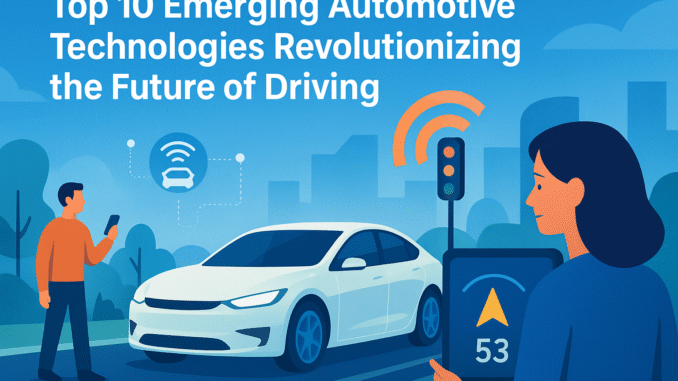
Top 10 Emerging Automotive Technologies Revolutionizing the Future of Driving
The automotive industry is undergoing a technological transformation unlike anything we’ve seen before. From electric vehicles (EVs) to self-driving cars, the next generation of automotive innovations is reshaping the way we think about transportation, safety, and sustainability. These technologies are not only improving how cars perform but also redefining how we interact with them and the world around us.
In this article, we’ll explore the top 10 emerging automotive technologies that are revolutionizing the future of driving.
1. Electric Vehicles (EVs) and Battery Innovations
Electric vehicles are no longer the future — they’re the present. Major automakers like Tesla, BYD, Ford, and Hyundai are leading the charge toward all-electric fleets. EVs are reducing our reliance on fossil fuels and offering cleaner, more efficient transportation options.
What’s driving this shift is the rapid improvement in battery technology. Innovations such as solid-state batteries promise faster charging times, longer ranges, and improved safety. For example, Toyota and QuantumScape are investing heavily in next-generation batteries that could power cars for over 500 miles on a single charge.
As global governments push for carbon neutrality, EV adoption will continue to accelerate, making electric mobility a cornerstone of modern transportation.
2. Autonomous Driving and AI Integration
Self-driving technology has evolved from science fiction into reality. Companies like Waymo, Tesla, and Cruise are developing autonomous vehicles (AVs) capable of navigating roads without human input.
The backbone of this innovation is Artificial Intelligence (AI). Advanced algorithms analyze massive amounts of data from cameras, sensors, radar, and LiDAR to make real-time driving decisions. The integration of machine learning allows these systems to improve over time, learning from millions of driving miles.
While fully autonomous vehicles (Level 5) are still in testing, semi-autonomous features — such as adaptive cruise control, lane-keeping assistance, and automatic emergency braking — are already enhancing safety and convenience for drivers worldwide.
3. Vehicle-to-Everything (V2X) Communication
Imagine a world where cars can “talk” to each other and to the surrounding infrastructure. That’s the vision behind Vehicle-to-Everything (V2X) technology.
V2X enables vehicles to exchange data with other vehicles (V2V), traffic signals (V2I), pedestrians (V2P), and even the cloud. This communication improves road safety, reduces traffic congestion, and enhances navigation efficiency.
For example, if a car ahead suddenly brakes or if a traffic light is about to change, nearby vehicles receive instant alerts. This can prevent collisions and optimize traffic flow, especially in smart cities where infrastructure is connected through the Internet of Things (IoT).
4. Advanced Driver Assistance Systems (ADAS)
ADAS has become one of the most influential automotive technologies in recent years. It refers to electronic systems that assist drivers in driving and parking functions.
Common ADAS features include:
- Adaptive Cruise Control
- Blind-Spot Detection
- Collision Avoidance Systems
- Lane Departure Warning
- Parking Assistance
These systems rely on cameras, radar, and ultrasonic sensors to detect potential hazards. With continuous improvements, ADAS is paving the way for safer roads by reducing human error — one of the leading causes of road accidents.
5. Connected Cars and the Internet of Things (IoT)
Modern vehicles are becoming smart devices on wheels. Through IoT technology, cars can now connect to the internet and communicate with other devices in real time.
Connected cars provide features like:
- Real-time traffic updates
- Remote diagnostics and vehicle health monitoring
- Over-the-air software updates
- Personalized infotainment systems
Automakers such as BMW, Mercedes-Benz, and Tesla are already offering vehicles that can receive software improvements remotely. This connectivity not only enhances convenience but also ensures vehicles stay up-to-date without visiting a dealership.
6. Augmented Reality Dashboards and Heads-Up Displays (HUDs)
Traditional dashboards are being replaced by augmented reality (AR) interfaces that project real-time information directly onto the windshield.
Imagine seeing navigation directions, hazard alerts, or speed limits overlaid on the road ahead — that’s what AR dashboards and Heads-Up Displays (HUDs) offer. This technology reduces driver distraction by keeping essential information within the driver’s line of sight.
Luxury brands like Audi, BMW, and Mercedes-Benz are leading the adoption of AR HUDs, while startups are developing affordable versions for mass-market vehicles.
7. Sustainable Materials and Green Manufacturing
Sustainability is becoming a central focus for the automotive industry. Beyond reducing emissions, car manufacturers are rethinking how vehicles are made.
The use of eco-friendly materials such as recycled plastics, organic fabrics, and plant-based composites is growing rapidly. For instance, BMW uses recycled fishing nets to make interior components, while Tesla incorporates vegan leather across its lineup.
Additionally, factories are shifting toward carbon-neutral production through renewable energy sources like solar and wind. These changes make automotive manufacturing more environmentally responsible and align with global climate goals.
8. Over-the-Air (OTA) Software Updates
The days of visiting a mechanic for minor software fixes are ending. Over-the-Air (OTA) technology allows automakers to remotely update a vehicle’s software — similar to how smartphones receive system updates.
OTA updates can:
- Improve performance and efficiency
- Add new features or enhance existing ones
- Fix security vulnerabilities
Tesla pioneered OTA updates, and now brands like Ford, Volkswagen, and Hyundai are following suit. This technology keeps vehicles safer, smarter, and more adaptable over time, extending their lifespan and value.
9. Hydrogen Fuel Cell Vehicles
While EVs dominate the conversation, hydrogen fuel cell technology offers another promising path toward zero-emission mobility. Instead of relying on batteries, hydrogen vehicles convert hydrogen gas into electricity through a chemical reaction, producing only water vapor as a byproduct.
Automakers such as Toyota (Mirai) and Hyundai (Nexo) are leading this innovation. Hydrogen fuel cells offer longer ranges and faster refueling times compared to traditional EVs, making them ideal for long-distance travel and commercial fleets.
As hydrogen infrastructure expands, this technology could become a major player in the green transportation ecosystem.
10. Smart Tires and Advanced Materials
The tires of the future will do much more than provide traction. Smart tire technology uses embedded sensors to monitor pressure, temperature, tread wear, and road conditions in real time.
Brands like Michelin and Goodyear are developing tires that can adapt to driving environments automatically, improving safety and performance. Some prototypes even feature self-healing materials that repair minor punctures on their own.
Smart tires not only enhance safety but also provide valuable data to vehicle systems, ensuring optimal performance and efficiency throughout a tire’s lifespan.
The Road Ahead: A Connected, Safer, and Greener Future
The automotive industry’s transformation is just beginning. The convergence of AI, IoT, renewable energy, and sustainable design is setting the stage for a smarter, safer, and more eco-friendly transportation system.
In the next decade, we can expect cars that are fully autonomous, completely connected, and powered by clean energy. This shift won’t just change how we drive — it will change how we live, commute, and interact with technology.
As consumers embrace these innovations, automakers and tech companies will continue to push boundaries, creating vehicles that not only move us but also protect the planet and make everyday life easier.
The future of driving isn’t just about getting from point A to point B — it’s about transforming mobility into an intelligent, sustainable, and connected experience.

